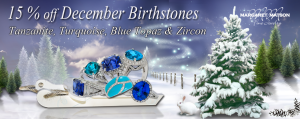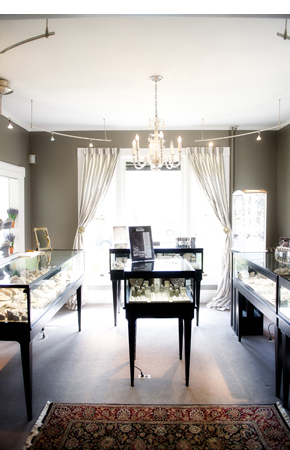 If one color doesn’t appeal to you, feel free to select another! December birthday celebrants have a winter’s sky full of color choices, from icy blue to twilight purple.
If one color doesn’t appeal to you, feel free to select another! December birthday celebrants have a winter’s sky full of color choices, from icy blue to twilight purple.
What makes a gemstone an “official” birthstone? Time, tradition and trends! The first century Jewish historian Josephus believed there was a connection between the 12 stones found in Aaron’s breastplate, which represented the 12 tribes of Israel, the 12 months of the year and the 12 signs of the zodiac. Over time, as tastes and traditions changed and mining efforts unearthed new gemstones, the birthstone list began to form. The official list, recognized by hundreds of jewelers, gem associations and societies around the world today, was set in 1912. It has had only one addition since that time, tanzanite, which was added in 2002.
Tanzanite: When discovered in 1967 by a Masai tribesman near Mt. Kilimanjaro in northern Tanzania, this stone was originally believed to be a new sapphire deposit. Tanzanite’s rich violet-blue color is achieved by heat-treatment. The sparkling stone is often used as a blessing for expectant mothers because of its reputation for helping to bring health and happiness.
Turquoise: Valued for its combination of ancient heritage and unforgettable color, this gem captures the cool colors from grass greens to a bright, medium-toned sky blue. Turquoise is found in the dry and barren regions of the Earth where acidic, copper-rich groundwater seeps downward and reacts with minerals that contain phosphorus and aluminum. Most often cut into cabochons, turquoise might also be cut into beads or flat pieces for inlays.
Blue Zircon: While its name is derived from the Arabic words zar and gun, meaning gold and color, zircon actually is found in a wide range of colors from blue, yellow, orange and brown, to green, colorless and red (the most prized color). The versatile gem is said to have power to relieve pain, whet the appetite, protect travelers from disease and injury, ensure a warm welcome and prevent nightmares.
Blue Topaz: Topaz’ many colors come from impurity elements or defects in its crystal structure. The element chromium causes the natural pinks, reds and violet-to-purple colors in topaz. Blue topaz, from the colorless variety of the gem, is irradiated with electrons at 10 million electron volts to create its vivid sky blue hue. In Renaissance Europe people thought that topaz could break magic spells and dispel anger. For centuries, many people in India have believed that topaz worn above the heart assures long life, beauty and intelligence.







No comments yet.